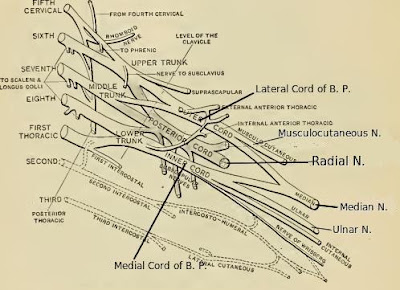The radial nerve is the thickest branch of the brachial plexus. It innervates the muscles of the posterior side of arm (triceps brachii) and forearm (anconeous, brachioradialis, extensor digitorum, extensor carpi ulnaris, and extensor indicis muscle). Therefore, damage to this nerve, caused by a broken humerus, may result in the inability to extend the fingers and the wrist, which is called "wrist drop", and the fingers. In old text, it is also known as the musculospiral nerve.
The radial nerve originates from the posterior cord of brachial plexus. This posterior cord is formed by the union of nerve fibers arising from the fifth, sixth, seventh, and eighth cervical roots (C5-C6-C7-C8). Just as it emerges from the brachial plexus, it travels down behind the axillary artery and behind the upper portion of the brachial artery as well. Then it spirals around the arm, switching position from the medial to the lateral side of humerus in the musculospiral (radial) grooves, with the deep brachial artery.
The radial nerve winds around once again to position itself on the anterior aspect of distal portion of humerus. When it has reached the forearm, it forks into the superficial branch, which is basically an afferent nerve, and a deep branch, which is efferent, supplying the extensor pollicis brevis muscle (of thumb) in the hand. The superficial afferent branch supplies the skin and subcutaneous tissue of forearm.
Below, the site of origin of radial nerve in brachial plexus.
The course of radial nerve in the arm. You can see why it was called the musculospiral nerve. Image from Gray's Anatomy, updated.






No comments